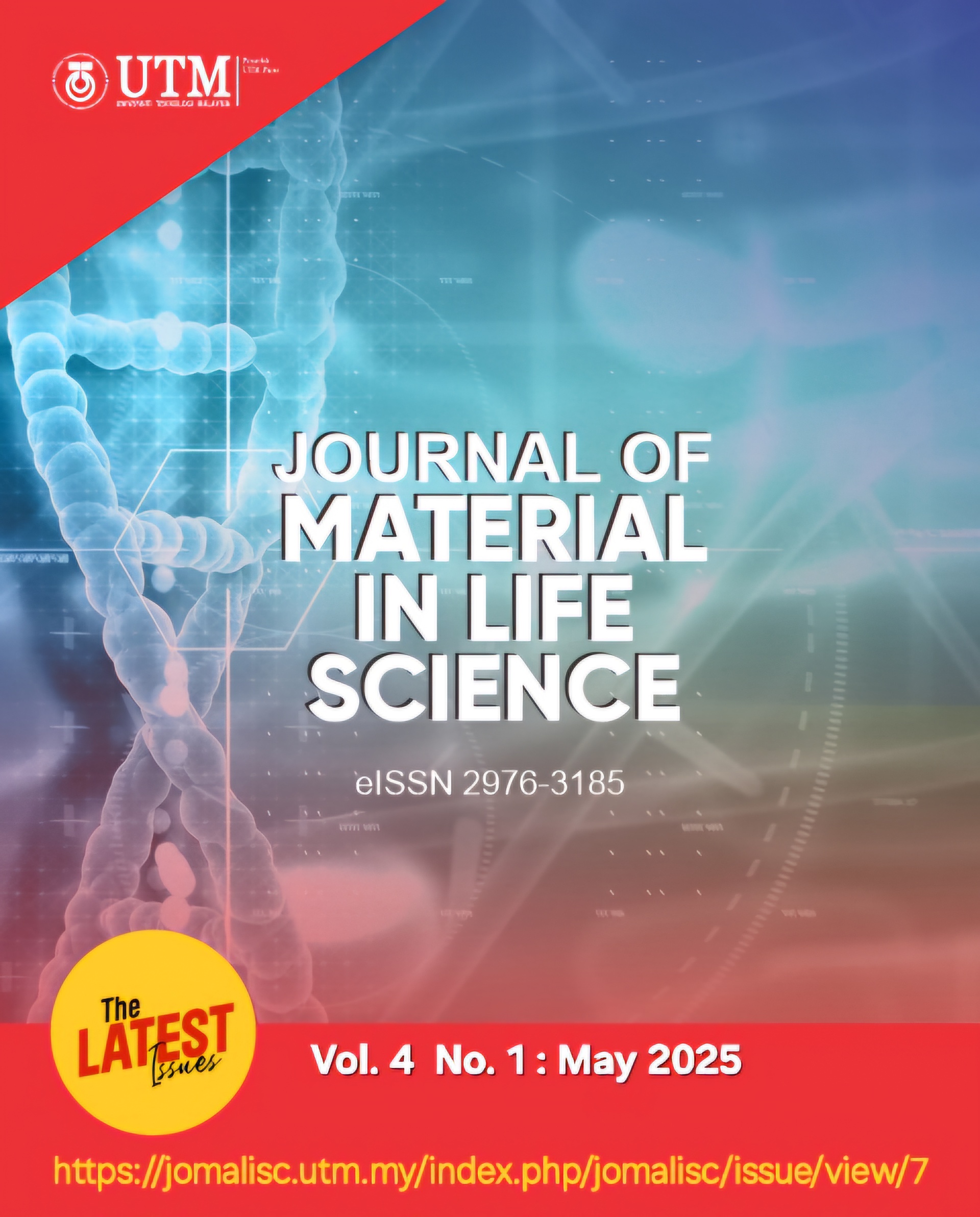Optimization of Magnetic Micro Solid-Phase Extraction Using Alginate Chitosan Amine-Functionalized Silica-Coated Adsorbent for Determination of Pyrocatechol in Coffee
DOI:
https://doi.org/10.11113/jomalisc.v4.89Keywords:
magnetic micro-solid phase extraction, pyrocatechol, coffee analysis, biopolymer functionalized adsorbent, UV-Vis spectrophotometryAbstract
This study aimed to optimize the parameters for magnetic solid-phase extraction (MSPE) for the analysis of pyrocatechol in coffee using ultraviolet-visible (UV-Vis) spectrophotometry instrument. The magnetic solid phase extraction (MSPE) adsorbent used was alginate chitosan amine-functionalized silica-coated (alg/Cs-NH2-SiO2/Fe3O4). The effect of desorption solvent, elution time, and mass of sorbent were investigated. The calibration curve showed a straight line with R2 = 0.9985, which showed that there was a linear relationship between the concentration of the substance and its response (absorbance). As the curve was linear, it showed that the instrument’s response was directly proportional to the concentration within the measured range. The optimum MSPE conditions were ethanol as the desorption solvent, 80 mg of alg/Cs-NH2-SiO2/Fe3O4 adsorbent and 30 seconds of extraction time. Under the optimized conditions, the MSPE method showed good linearity in the range of 1-10 mg/L with coefficient of determination R2 = 0.9965. The method showed limit of detection (LOD) and limit of quantification that were calculated to be 1.0 mg/L. Good precision achieved with relative standard deviations (RSD) < 10% and good repeatability 0.55%. The developed method was successfully applied to the analysis of pyrocatechol in coffee. The consistency of absorbance values observed across multiple measurements (1.438, 1.430, and 1.435) suggests reproducibility and reliability of the experimental results. These findings demonstrate the stability and robustness of the UV-Vis analysis technique used in this study.
References
Lim, L. T., Zwicker, M., & Wang, X. (2019). Coffee: One of the most consumed beverages in the world. International Food Research Journal, 26(1), 1–10.
Chu, Y. F., Ho, C. T., & Wang, Y. (2009). Roasted coffees high in lipophilic antioxidants and chlorogenic acid lactones are more neuroprotective than green coffees. Journal of Agricultural and Food Chemistry, 57(20), 9801–9808.
Funakoshi-Tago, M., Tago, K., & Tominaga, Y. (2022). Coffee ingredients, hydroquinone, pyrocatechol, and 4-ethylcatechol exhibit anti-inflammatory activity through inhibiting NF-κB and activating Nrf2. Journal of Functional Foods, 90, 104980.
Motilva, M. J., Serra, A., & Macià, A. (2013). Analysis of food polyphenols by ultra-high-performance liquid chromatography coupled to mass spectrometry: An overview. Journal of Chromatography A, 1292, 66–82.
Giakisikli, G., & Anthemidis, A. N. (2013). Magnetic materials as sorbents for metal/metalloid preconcentration and/or separation: A review. Analytica Chimica Acta, 789, 1–16.
Amiri, A., Baghayeri, M., & Nori, S. (2018). Magnetic solid-phase extraction of polycyclic aromatic hydrocarbons using a graphene oxide/Fe₃O₄@polystyrene nanocomposite. Microchimica Acta, 185(3), 1–9.
Dagil, G. S., Sapin, N., & Abdul Keyon, A. S. (2023). Novel alginate–chitosan amine-functionalized silica-coated magnetic composite for heavy metals removal in water. Malaysian Journal of Analytical Sciences, 27(2), 422–439.
Wang, Z., Li, C., & Zhao, Y. (2018). Highly efficient removal of toxic Pb²⁺ from wastewater by an alginate–chitosan hybrid adsorbent. Journal of Chemical Technology and Biotechnology, 93(9), 2691–2700.
De Sousa Victor, R., Leite, P. E. C., & Lins, R. D. (2020). A review on chitosan’s uses as biomaterial: Tissue engineering, drug delivery systems and cancer treatment. Materials, 13(23), 4995.
Sapin, N., Dagil, G. J., & Abdul Keyon, A. S. (2024). Alginate–chitosan amine-functionalized silica-coated magnetic adsorbent for magnetic micro solid-phase extraction of bisphenol A from canned food sample. Journal of Materials in Life Sciences, 3(1), 41–48.


















